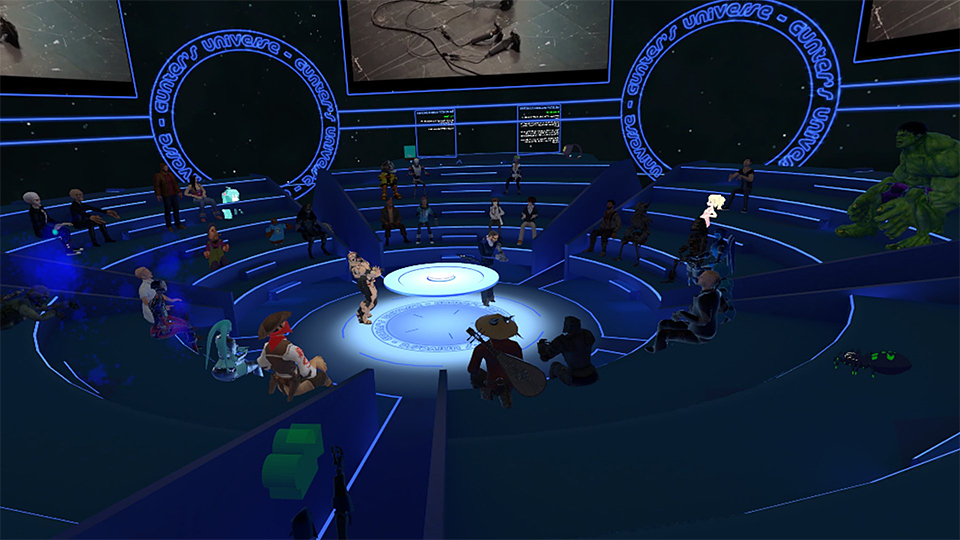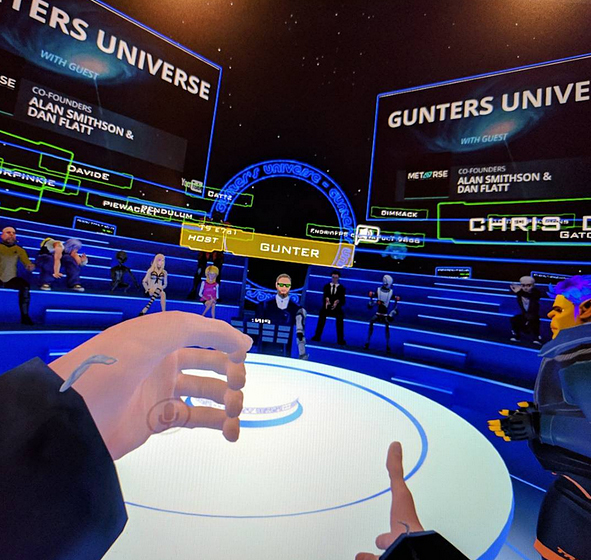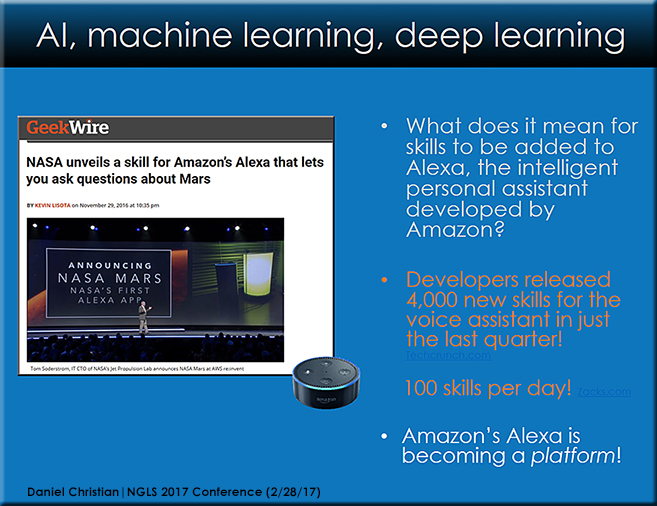From DSC:
A classroom of the future perhaps? These graphics depict VR-based chats/talk shows from @guntersuniverse



Amazon introduces Echo Show
The description reads:
From DSC:
Now we’re seeing a major competition between the heavy-hitters to own one’s living room, kitchen, and more. Voice controlled artificial intelligence. But now, add the ability to show videos, text, graphics, and more. Play music. Control the lights and the thermostat. Communicate with others via hands-free video calls.
Hmmm….very interesting times indeed.

Developers and corporates released 4,000 new skills for the voice assistant in just the last quarter. (source)
…with the company adding about 100 skills per day. (source)
![The Living [Class] Room -- by Daniel Christian -- July 2012 -- a second device used in conjunction with a Smart/Connected TV](http://danielschristian.com/learning-ecosystems/wp-content/uploads/2012/07/The-Living-Class-Room-Daniel-S-Christian-July-2012.jpg)
Addendum on 5/10/17:
Microsoft Cortana-Powered Speaker Challenges Amazon’s Echo With Skype Calls — from foxbusiness.com by y Jay Greene
Excerpt:
Microsoft Corp. is hoping to challenge Amazon.com Inc.’s Echo smart speaker for a spot on the kitchen counter with a device from Samsung Electronics Co. that can make phone calls. The Invoke, which will debut this fall, comes more two years after the release of the Echo, which has sold more 11 million units through late last year, according to estimates by Morgan Stanley. It also will compete with Alphabet Inc.’s Google Home, which was released last fall. The voice-controlled Invoke, made by Samsung’s Harman Kardon unit, will use Microsoft’s Cortana digital assistant to take commands.
Microsoft Screams ‘Me Too’ With Cortana-Powered Rival to Amazon Echo and Google Home — from gizmodo.com by Alex Cranz
Excerpt:
With Microsoft’s Build developer conference just two days away, the company has revealed one of the most anticipated announcements from the event: A new Cortana-powered speaker made by German audio giant Harman Kardon.
Now, it’s fair to see this speaker for what it is: An answer to the Google Home and Amazon Echo. Both assistant-powered speakers are already in homes across our great nation, listening to your noises, noting your habits, and in general invading your lives under the guise of smart home helpfulness. The new Microsoft speaker, dubbed “Invoke,” one will presumably do the good stuff, let giving you updates on the weather and letting you turn on some soothing jazz for your dog with just a spoken command. Microsoft is also hoping that partnering with Harmon Kardon means its speaker can avoid one of the bigger problems with these devices—their tendency to sound cheap and tinny.

Harman Kardon’s Invoke speaker is a Cortana-powered take on an Amazon Echo — from theverge.com by Chaim Gartenberg
Excerpt:
As teased earlier, the Invoke speaker will offer 360-degree speakers, Skype calling, and smart home control all through voice commands. Design-wise, the Invoke strongly resembles Amazon’s Echo that its meant to compete with: both offer a similar cylindrical aluminum shape, light ring, and a seven-microphone array. That said, Harmon Kardon seems to be taking the “speaker” portion of its functionality more seriously than Amazon does, with the Invoke offering three woofers and three tweeters (compared to the Echo, which offers just a single of each driver). Microsoft is also highlighting the Invoke’s ability to make and receive Skype calls to other Skype devices as well as cellphones and landlines, which is an interesting addition to a home assistant.
From DSC:
Here we see yet another example of the increasing use of voice as a means of communicating with our computing-related devices. AI-based applications continue to develop.

From DSC:
This type of technology could be good, or it could be bad…or, like many technologies, it could be both — depends upon how it’s used. The resources below mention some positive applications, but also some troubling applications.
Lyrebird claims it can recreate any voice using just one minute of sample audio — from theverge.com by James Vincent
The results aren’t 100 percent convincing, but it’s a sign of things to come
Excerpt:
Artificial intelligence is making human speech as malleable and replicable as pixels. Today, a Canadian AI startup named Lyrebird unveiled its first product: a set of algorithms the company claims can clone anyone’s voice by listening to just a single minute of sample audio.
Also see:
Imitating people’s speech patterns precisely could bring trouble — from economist.com by
You took the words right out of my mouth
Excerpt:
UTTER 160 or so French or English phrases into a phone app developed by CandyVoice, a new Parisian company, and the app’s software will reassemble tiny slices of those sounds to enunciate, in a plausible simulacrum of your own dulcet tones, whatever typed words it is subsequently fed. In effect, the app has cloned your voice. The result still sounds a little synthetic but CandyVoice’s boss, Jean-Luc Crébouw, reckons advances in the firm’s algorithms will render it increasingly natural. Similar software for English and four widely spoken Indian languages, developed under the name of Festvox, by Carnegie Mellon University’s Language Technologies Institute, is also available. And Baidu, a Chinese internet giant, says it has software that needs only 50 sentences to simulate a person’s voice.
Until recently, voice cloning—or voice banking, as it was then known—was a bespoke industry which served those at risk of losing the power of speech to cancer or surgery.
…
More troubling, any voice—including that of a stranger—can be cloned if decent recordings are available on YouTube or elsewhere. Researchers at the University of Alabama, Birmingham, led by Nitesh Saxena, were able to use Festvox to clone voices based on only five minutes of speech retrieved online. When tested against voice-biometrics software like that used by many banks to block unauthorised access to accounts, more than 80% of the fake voices tricked the computer.
Per Candyvoice.com:
Expert in digital voice processing, CandyVoice offers software to facilitate and improve vocal communication between people and communicating objects. With applications in:
Health
Customize your devices of augmentative and alternative vocal communication by integrating in them your users’ personal vocal model
Robots & Communicating objects
Improve communication with robots through voice conversion, customized TTS, and noise filtering
Video games
Enhance the gaming experience by integrating vocal conversion of character’s voice in real time, and the TTS customizing
Also related:
From DSC:
Given this type of technology, what’s to keep someone from cloning a voice, putting together whatever you wanted that person to say, and then making it appear that Alexa recorded that other person’s voice?
From DSC:
I appreciate the innovative work of Dr. Susan Aldridge and Marci Powell; check the Virtually Inspired site out for some examples of what I’m talking about.
What to look for when hiring an entry-level data scientist? — from datasciencecentral.com
Excerpt:
What I look for the most is some signal that the junior data scientist:
Let’s put aside the need for some level of formal training, that is a non-negotiable baseline. You have to have enough understanding of mathematics and statistics to know when you are getting yourself into trouble, you have to understand data management practice enough to understand how to access data, and you have to understand enough about machine learning to make the appropriate series of tradeoffs in model development and validation. That is table stakes, however what makes one candidate stand out above the others is everything else surrounding these core concepts.
Also see:
Microsoft Announces New Laptops and OS Perfect for 21st-Century Students — from edtechmagazine.com by Meghan Bogardus Cortez
Windows 10 S, Surface Laptop and other updates are coming to classrooms in the fall.
Excerpt:
Surface Laptop Introduces Seamless Technology
Perhaps the biggest cheers from the crowd came from the announcement of the new Surface Laptop, which will be available in June 2017.
…
The laptop checks in at 2.76 pounds with a 13.5-inch PixelSense display and 3:2 aspect ratio. Equipped with a fabric overlay on the backlit keyboard, the laptop is so seamless it doesn’t even have speaker grills. Instead, Panay says users can be immersed in sound while working on things like video. With a Surface Pen and the laptop’s LCD touch module, annotation is easy, even on videos.
Microsoft Debuts Surface Laptops, Windows 10 S for Education, Teams for Office 365 for Education — from campustechnology.com by David Nagel
Excerpt:
Microsoft has unveiled several new offerings for education, including the forthcoming Surface Laptop and a new version of Windows 10 designed for school environments — Windows 10 S.
Also see:
Also see:
From Mixed Reality to New Minecraft and OS, Microsoft Unleashes a Flurry of EDU Upgrades — from edsurge.com by Jenny AbamuMay
Excerpt:
“How can technology create more opportunity, not for a few but for all,” asked Nadella, noting how his own grandfather was not able to go to school because of the limited resources his family had. “Democratizing education must be something that is for everyone and not just for a select few, this is something that is deeply personal.”
His passionate and personal plea set the tone for the flurry of announcements and updates that followed. By the end of the whirlwind showcase, educators were weary but excited about future possibilities.
Also see:
Microsoft Unveils K-12 Operating System, Tools to Challenge Google — from edweek.org by Sean Cavanagh
Excerpt:
Microsoft unveiled a new, streamlined operating system, a slim laptop and a bevy of classroom tools, a group of products that in design and spirit seem aimed at competing with ascendant Chromebooks and other Google offerings in the school market.
At a product announcement on Tuesday crowded with company employees and tech journalists, Microsoft executives repeatedly touted a theme in describing the new operating system, Windows 10 S, and the accompanying products: simplicity.
The goal is “simplify to magnify,” Terry Myerson, Microsoft’s executive vice president of the Windows and devices group, told the assembled crowd. “Simplicity is power.”
“Technology should help, not hinder, teachers’ work in the classroom,” Microsoft CEO Satya Nadella said. It should make educators’ jobs easier, and “spark students’ creativity.”
Impressive surrealist photo editing by Hüseyin Sahin — from designer-daily.com

Also see:
Spectacular sculptures made of glass and concrete by Ben Young — from designer-daily.com

From DSC:
I ran across this animation that I saw over 7 years ago (and recorded some audio/thoughts about it at that time). I did so because I thought it was a great illustration of a Learning Ecosystem. I thought I’d re-post it here — because I still think that’s the case.
‘Volatile’ but growing online ed market — from insidehighered.com by Carl Straumsheim
Online enrollment continues to grow as the total number of students in college shrinks. The growth is particularly strong at private nonprofit colleges, report finds.
Excerpt:
The enrollment growth at private nonprofit colleges means the sector has passed for-profit colleges as the second-largest in the distance education market. Public institutions still teach the majority of online students: 67.8 percent, according to the 2015 data. Of the six million who studied online in fall 2015, 4.1 million attended public institutions, one million private nonprofit colleges and about 871,000 for-profit institutions.
From DSC:
And this growth is without the next wave of artificial intelligence-enabled applications and customized/personalized services that it will deliver.
I fully well realize that even if AI-based education comes into existence (which it will) and the online world delivers incredible learning experiences — and results — many people will still want to learn in a face-to-face manner. I get it.
But especially for the lifelong learner, colleges and universities need to move towards implementing more programs aimed at helping lifelong learners QUICKLY reinvent themselves.